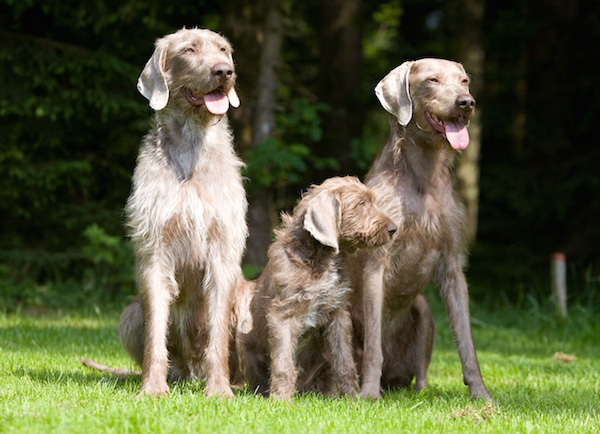
After WWII, the loss of many Czechoslovakian hunting dogs coupled with a change in the way people hunted lead to the creation of a breed that could point, hunt and retrieve. It took sixty years for Koloman Slimak and the breeders working with him to develop the Slovakian Rough Haired Pointer. By combing the German Wirehaired Pointer, Cesky Fousek, and Weimaraner, these breeders hoped they would produce a dog that could track, point, scent, and retrieve in water or on land with tremendous stamina. The breed needed to be biddable, not range too far (Czech test rules sought a dog seeking at 30 paces in front, and 80 paces to each side), and have a particular aptitude for finding shot game. By most accounts, they got it. The Slovakian can cover the ground at a good pace, and in general, is an air scenting dog (though some hunters have found them to work out a ground scent before lifting their head to take in a breeze). SRHPs are described as good steady pointers, natural tracking dogs, and solid retrievers with soft mouths.
The United Kingdom’s Kennel Club has the Slovakian listed as an “interim” breed. It was added to the Imported Breed Register where it’s classified as a member of the hunt, point, retrieve gundog sub-group. The SRHP may now be shown in the UK in the AV Import Register. The breed is also recognized by the North American Versatile Hunting Dog Association, and the Malaysian Kennel Association.
In Slovakia, no registered dog can be bred without having passed hunting tests, and it’s said that the majority of UK bred dogs are the result of direct imports. Most Slovak Pointers are still bred in Slovakia with some 30 to 50 pups being whelped annually.
Early on, there was a bit of fuss concerning the breed name. In one account, a grey colored puppy born from Cesky Fousek parents was bred to a Weimaraner by Koloman Slimak. A puppy from the resulting litter was bred to another Weimaraner. During this time, two more wiry, grey puppies were born in a litter of Fouseks, and they were crossed with the dogs bred by Slimak. The dogs were all originally registered as Wirehaired Weimaraners, a name that was put forward to the Weimaraner Club of Germany when the organization was asked to recognized the dogs as such. The request was denied.
Another source writes that it was because of a mistake in the translation of the Weimaraner standard into Slovakian that the breed was registered as a Rough Haired Weimaraner to begin with. It wasn’t until 1975 that the error was identified by the aforementioned German Weimaraner Club, and this is why the club didn’t approve the request. The breed was removed from the Weimaraner classification.
SRHP enthusiasts in Slovakia persuaded the FCI to recognize the breed by the name it’s known by today, but it wasn’t until 1982 that the breed gained FCI approval becoming breed number 320. By the end of 1984, there were 550 dogs registered in the studbook, and of those, 260 had passed tests (30 with forest and special work tests, and 26 with full utility tests). This breed could work!
For more information on the Slovakian Rough-Haired Pointer, we suggest you refer to Craig Koshyk’s wonderful volume, Pointing Dogs: The Continentals.
Image found on Pinterest and happily credited upon receipt of information.
